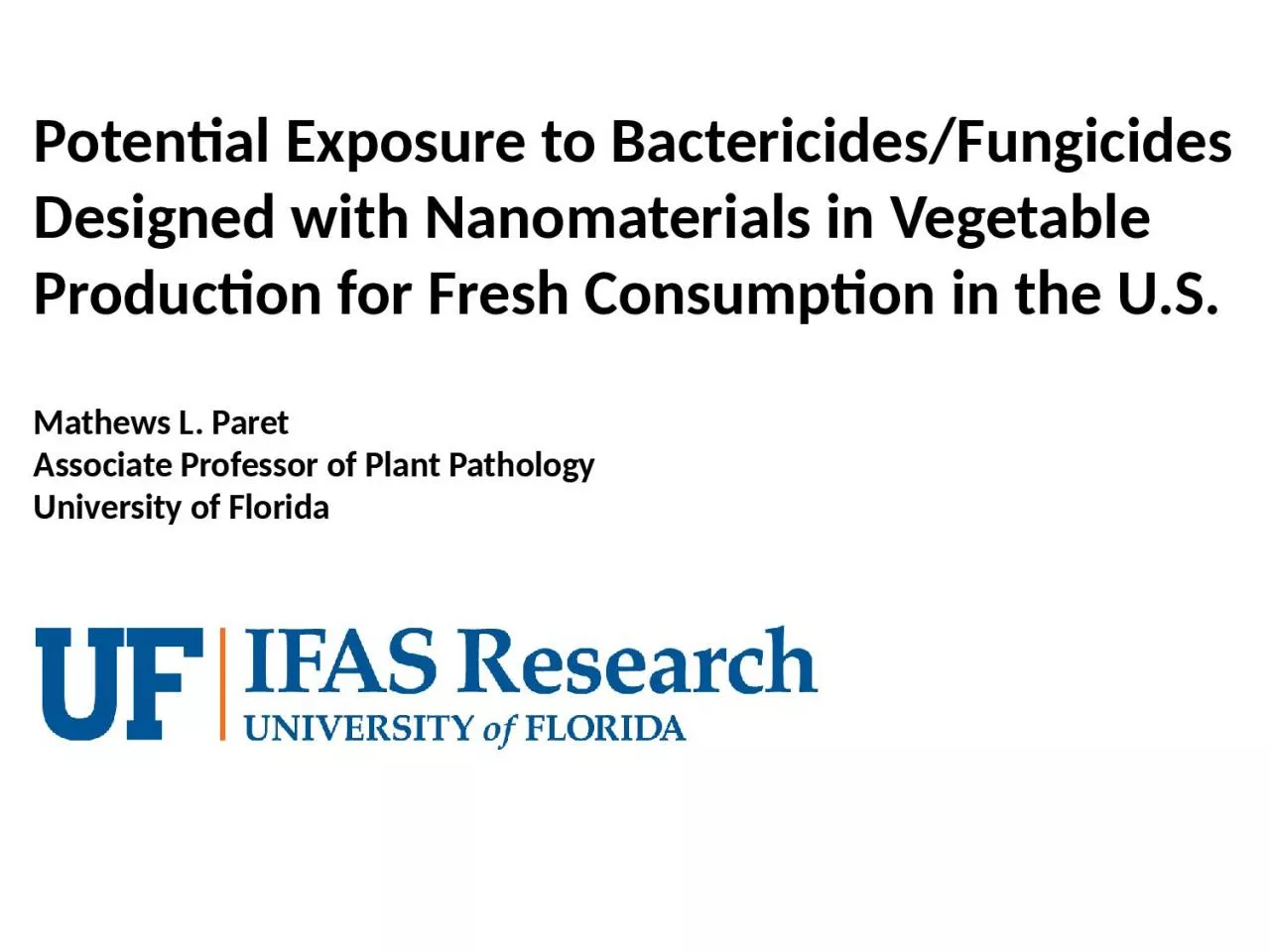

Mathews L Paret Associate Professor of Plant Pathology University of Florida The US Fresh Market Tomato Industry 2017 gt92000 acres harvested gt12 billion in value Florida 33000 acres ID: 1039528
Download Presentation The PPT/PDF document "Potential Exposure to Bactericides/Fungi..." is the property of its rightful owner. Permission is granted to download and print the materials on this web site for personal, non-commercial use only, and to display it on your personal computer provided you do not modify the materials and that you retain all copyright notices contained in the materials. By downloading content from our website, you accept the terms of this agreement.
1. Potential Exposure to Bactericides/Fungicides Designed with Nanomaterials in Vegetable Production for Fresh Consumption in the U.S. Mathews L. ParetAssociate Professor of Plant PathologyUniversity of Florida
2. The U.S Fresh Market Tomato Industry (2017): >92,000 acres harvested; >$1.2 billion in valueFlorida: 33,000 acresCalifornia: 28,600 acres
3. Bacterial Spot of Tomato - Topmost among bacterial diseases of tomato in the U.S and worldwideFirst discovered in South Africa in 1914 Caused by 4 distinct species of Xanthomonas (X. euvesicatoria, X. gardneri, X. perforans, and X. vesicatoria). X. perforans is the dominant species in FloridaThe disease can cause 20-50% yield losses under ideal conditions for bacterial spread
4. How does a typical disease management program for bacterial spot (only!) by foliar application on tomato in Florida looks like? AntibioticsCopper + MancozebSAR Inducers (e.g. Actigard, Leap, Vacciplant)Bacteriophages and other bio-control agents1-2 times: Used during 1950s; continuous field use led to bacterial resistance development. Currently only used in transplant production.10-20 times: As of 2006, all X. perforans strains (375+) in Florida are copper-tolerant.5-10 times: Tank mix or rotation partner as a protectant with all above materials. Effectiveness is inconsistent and environment dependent.6-10 times. Risks of yield reduction with Actigard
5. Alternative materials that killed copper tolerant X. perforans strainsTiO2/Zn and TiO2/Ag – Photocatalytic nanomaterials killed cells at 500 ppm, but caused phytotoxicity on plants (Partner: Ecoactive Surfaces)Ag-ds-DNA-GO nano – Ag nanomaterials killed cells at 13 ppm (Partner: Dr. Weihong Tan)Copper composites (copper-core shell silica, copper-multivalent, copper-fixed quat) (Partner: Dr. Swadeshmukul Santra)Metal oxides (MgO & others) - MgO killed cells at 75 ppm - U.S NanoCu/Zn hybrid - Killed cells at 100 ppm - U.S NanoIn comparison: Conventional copper (Kocide 3000) did not kill cells even at 500-1000 ppm
6. Lets do a simple math on CuIn Florida copper is used as on tomatoes up to 10-20 times in a single season. ~36% of the total Cu sprayed can be found in runoff from plants which contributes to a very high accumulation level of Cu in soil that is detrimental to soil microorganisms, and aquatic organisms (Merrington et al., 2002; Rice et al., 2003).Kocide 3000 - 27 lb/A (Maximum season rate which corresponds to ~10 lb/A of elemental copper/season (2; 20 lb/A) which comes to ~600,000 lbs of Cu annually (30,000 + acres of tomato).What does this mean for elemental accumulation in tomatoes (fruits)? MgO was used as a model material for evaluationCollaborator: Dr. Jason White
7. PeelFlesh
8. Whole fruit
9. Nanomaterial designEfficacyFruit, leaf, soil accumulationTrophic transferImpact on non-targets (microbiomes)Compatibility with other materials, cost-benefit ratioOccupational safetyStructural framework from a plant pathologist perspectiveKocide 3000 – 27 lb/A (Maximum season rate which corresponds to ~10 lb/A of elemental copper/season (2; 20 lb/A) which comes to ~600,000 lbs of Cu annually (30,000 + acres of tomato).Hypothetical: With copper-composites effectiveness at 1/5th the concentration to commercial Cu, we can potentially reduce Cu levels in FL tomatoes from ~600,000 lbs to ~240,000 lb with better bactericidal properties if 50% adoption of a product. Similarly MgO can significantly reduce copper load in the environment.IDENTIFY A CLEAR ISSUE, ON WHY NANOTECHNOLOGY?Copper-toleranceFungicide resistanceCopper loadparet@ufl.edu